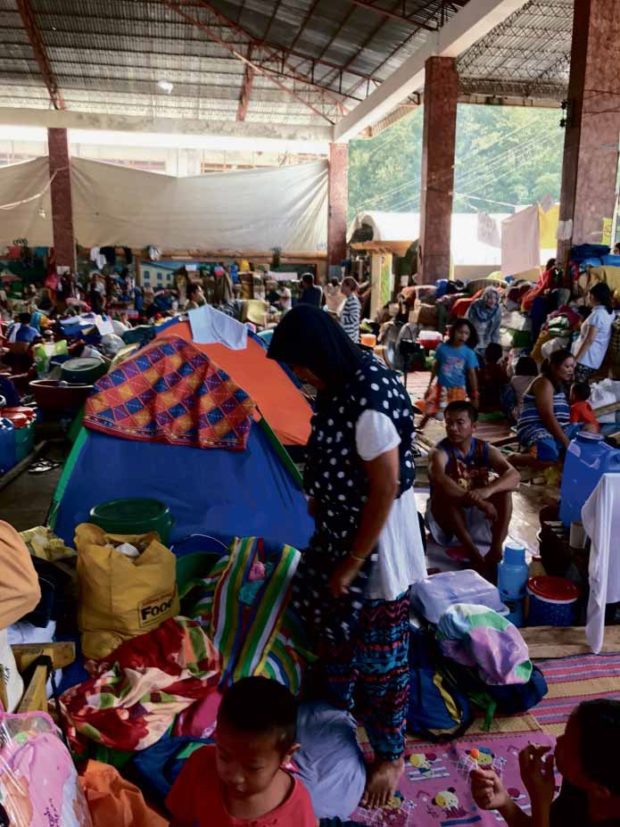40,000 Marawi evacuees suffer in emergency shelters

CROWDED People who fled war-torn Marawi City occupy overcrowded and unsanitary evacuation centers in Iligan City, including this shelter in Barangay Buru-un. —ALLAN NAWAL
ILIGAN CITY — Four weeks since fierce fighting broke out between government forces and Islamic State-inspired terrorists in Marawi City, some people who fled the battle are falling ill and dying in overcrowded and unsanitary evacuation centers, health officials say.
Up to 230,000 people have fled the fighting in Marawi and nearly 40,000 are huddled in emergency shelters set up in community halls, gymnasiums and Islamic schools.
24 dead
At least 24 people have died from dehydration, pneumonia and other illnesses in the centers, Health Secretary Paulyn Ubial said on Monday.
Ubial denied during the weekend that she reported 59 deaths in the evacuation centers at a news conference in Legazpi City in Albay province last week.
Speaking to reporters in Quezon City on Monday, Ubial maintained that she referred to 19 deaths, not 59. She said the 19 deaths were mostly due to preexisting conditions such as diabetes, cancer and hypertension.
Article continues after this advertisementThere have been five more deaths since last week, Ubial said. “Now we have 24 deaths,” she said.
Article continues after this advertisementAt least two of the fatalities were due to diarrhea, according to Alinader Minalang, the health director for Lanao del Sur province.
Diarrhea, malnutrition
Three hundred cases of diarrhea have been recorded among the evacuees, he said.
“The cause of the increase in diarrhea cases is sanitation issues and a lack of sources of potable water,” Minalang said.
In the centers, families of up to a dozen people sleep together on hard concrete floors, and in some places hundreds are sharing a single toilet.
The evacuees are also afflicted by malnutrition.
Nelia Sarap, a nutrition specialist at the Lanao del Sur Integrated Provincial Health Office (IPHO), said that while the number of cases of malnutrition among the most vulnerable age group of children was still less than 5 percent as of Monday, it would definitely increase because of overcrowding and sanitation.
“Out of 649 children under the most vulnerable age group, 6 to 59 months, that we have monitored, there were six cases of acute malnutrition so far. For moderately malnourished, we have recorded 20,” Sarap said.
She said the figures came from only five evacuation centers—in the towns of Saguiaran and Piagapo in Lanao del Sur, and in Balo-i, Pantar and Pantao Ragat in Lanao del Norte, and that the malnutrition had been acquired before the evacuation.
“The figures did not include those in other Lanao del Norte areas, including Iligan City, because we had an agreement with the Department of Health (in Northern Mindanao) that they would be the one to monitor these areas,” she said.
Unsanitary conditions
Sarap said that while there have been no reported deaths from malnutrition acquired at evacuation centers yet, deaths are not a remote possibility, as the evacuees are not getting the correct nutrients that they need.
“The relief goods consisting of sardines, noodles and rice would not provide them the needed nutrition,” she said.
Sarap said the unsanitary conditions in the shelters also posed dangers to the evacuees because if they contracted diarrhea, they would lose nutrients faster than healthier evacuees.
“And when this happens, we would see more weak bodies, more diseases, and possibly, deaths,” she said.
Minalang said health workers were also conducting tests to verify a reported case of cholera.
“We still cannot say it’s cholera,” he said.
Racing against time
Dr. Kadil Sinolinding, the health secretary for the Autonomous Region in Muslim Mindanao (ARMM), said a single case of cholera would become “a big headache for everyone,” as it is highly contagious.
“It could cause an outbreak in no time,” he said.
Sinolinding said health workers were racing against time to prevent the spread of highly communicable diseases among evacuees.
“This could get worse if the situation dragged on,” Sarap added.
She said health workers were distributing micronutrient-packed ready-to-eat food to children under 5 years old to prevent an outbreak of disease.
“We hope this would help them somehow,” she said.
Sanitation problem
Nesphia Ali, a volunteer for the Department of Social Welfare and Development (DSWD) in Balo-i town, said sanitation was the biggest problem in the shelters.
She said the more than 1,025 evacuees at the cultural center in Balo-i shared one toilet and the area had become filthy.
“We cannot put up more toilets because of lack of space,” she said.
To prevent the outbreak of disease, she said, social workers asked the authorities to move the evacuees to the more spacious Balo-i airport.
“They can’t be in this situation forever because if we won’t move them out, we will encounter a much larger problem. We would be dealing with more serious illnesses if we won’t do that,” she said. —With reports from Julie M. Aurelio and the wires